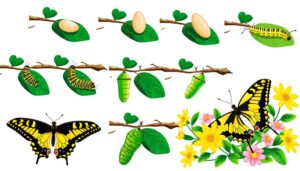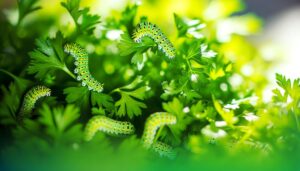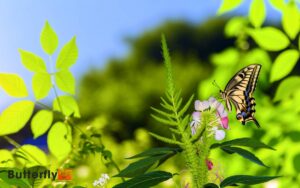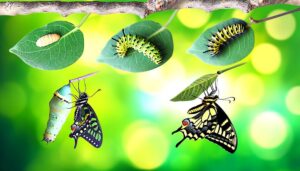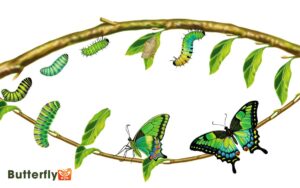Caterpillar Black Swallowtail Butterfly When It Comes Out of Egg?
Upon hatching from a spherical egg, the Black Swallowtail caterpillar measures approximately 2 millimeters. It immediately consumes the eggshell, providing essential nutrients.
Sporting a black body with a distinctive white saddle and setae, it begins feeding on host plant leaves rich in required carbohydrates and proteins.
The caterpillar’s mandibles are precisely adapted for efficient foliage consumption, allowing it to ingest up to 50% of its body weight daily.
This rapid intake is vital for advancing through its five instar stages, each marked by significant morphological transformation. Understanding these initial stages offers a glimpse into its complex life cycle.
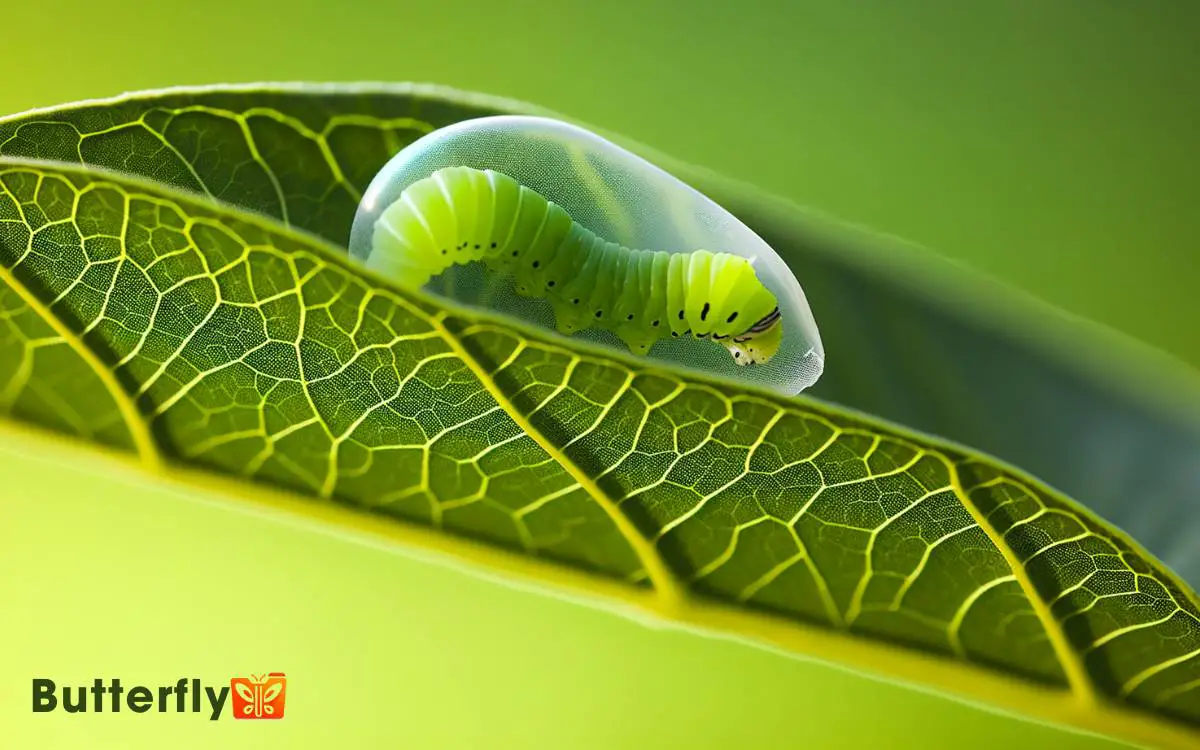
Key Takeaways
Egg to Caterpillar
The life cycle of the Black Swallowtail butterfly begins when a single, spherical egg, approximately 1 millimeter in diameter, is laid on a host plant. As the egg hatches, a tiny caterpillar emerges and begins feeding on the leaves of the host plant. This caterpillar, known as the parsley worm, grows through several stages, shedding its skin multiple times before forming a chrysalis. Inside the chrysalis, it undergoes metamorphosis, transforming from parsley worm to black swallowtail, eventually emerging as a striking adult butterfly.
Typically, the chosen plants belong to the Apiaceae family, such as parsley, dill, or fennel. The egg’s surface exhibits a subtle, reticulated texture, providing a protective layer for the developing larva inside.
Over a span of four to nine days, embryonic development progresses swiftly. Microscopic observation reveals the gradual formation of the caterpillar’s structures. Temperature and humidity play pivotal roles in determining the exact duration of development.
As the egg’s hue changes from pale yellow to dark gray, it indicates the nearing emergence of the larva, ready to start its voracious feeding journey.
First Moments
Emerging from the egg, the newly hatched caterpillar measures approximately 2 millimeters in length and immediately begins consuming the remnants of its eggshell, a behavior that provides essential nutrients for its initial growth.
Within moments, it displays a high degree of motility, using its prolegs and thoracic legs to explore its immediate surroundings.
Its body, initially black with a white saddle, exhibits minuscule setae that offer sensory feedback. The caterpillar’s head capsule, equipped with mandibles, is perfectly adapted for its first activities.
The newly emerged larva’s rapid movements and initial feeding behaviors are critical for its survival. These first moments mark the beginning of a remarkable transformation, demonstrating an intrinsic drive for growth and adaptation in its natural habitat.
Initial Feeding
With its initial exploration complete, the caterpillar begins to consume the host plant’s leaves, utilizing its specialized mandibles to efficiently break down the foliage. This early feeding phase guarantees rapid growth and development.
Observations reveal several key behaviors during this period:
- Importance for Young Leaves: The caterpillar selects tender, nutrient-rich leaves, optimizing its intake.
- Swift Consumption: It devours the foliage with remarkable speed, consuming up to 50% of its body weight daily.
- Precise Mandible Movements: The mandibles operate like finely tuned instruments, cutting and chewing leaves with high precision.
- Excretion of Frass: Waste material, known as frass, is expelled regularly, indicating efficient digestion.
These behaviors are essential for the caterpillar’s survival and subsequent metamorphosis stages.
Nutritional Needs
Understanding the nutritional needs of the Black Swallowtail caterpillar is essential for ensuring its successful growth and development.
The primary food source for this species is plants in the Apiaceae family, such as parsley, dill, and fennel. These plants provide critical nutrients, including carbohydrates, proteins, and essential amino acids.
A caterpillar consumes approximately 0.5 grams of foliage daily during its early instar stages, increasing to around 1.5 grams as it matures.
Consistent access to fresh, pesticide-free leaves is crucial. Nutrient deficiencies can lead to developmental abnormalities and increased mortality rates.
Monitoring leaf quality and ensuring a diverse diet within the preferred plant family supports excellent health. Such precision in dietary management fosters resilient, well-developed caterpillars.
Growth Stages
As the Black Swallowtail caterpillar consumes its nutrient-rich diet, it progresses through five distinct instar stages marked by significant morphological changes and growth spurts.
Each instar is essential for its development, characterized by observable changes in size, color, and texture.
- First Instar: Measuring approximately 1.5 mm, it features a black body adorned with white spots.
- Second Instar: Growing to about 4 mm, it exhibits a dark green hue with spiny tubercles.
- Third Instar: Reaching 8 mm, the caterpillar adopts a more vibrant green and pronounced stripes.
- Fourth Instar: At 14 mm, it displays larger yellow and black banding.
Throughout these stages, the caterpillar demonstrates an accelerated growth rate, preparing for the transformative next phases.
Molting Process
The molting process in the Black Swallowtail caterpillar involves shedding its exoskeleton to accommodate rapid growth and development.
This process, known as ecdysis, occurs five times throughout the larval stage. Each molt is meticulously timed and can be observed by the splitting of the old exoskeleton along the dorsal line.
The caterpillar then wriggles free, revealing a new, larger exoskeleton. Typically, the inter-molt period lasts between 3 to 7 days, depending on temperature and food availability. Precise measurements indicate that the caterpillar’s size increases exponentially with each molt.
For instance, from first instar to fifth instar, the body length can grow from approximately 2 mm to over 45 mm. This rapid growth ensures the caterpillar is well-prepared for its pupal stage.
Defense Mechanisms
Although vulnerable during its larval stage, the Black Swallowtail caterpillar employs a variety of defense mechanisms to deter predators and enhance its chances of survival.
These caterpillars exhibit remarkable adaptations for self-preservation:
- Osmeterium: A glandular organ that emits a foul-smelling secretion when threatened, effectively repelling predators.
- Cryptic Coloring: Early instars resemble bird droppings, providing camouflage and reducing detection by predators.
- Spines: Sharp, protruding structures that dissuade potential attackers from attempting to consume them.
- Toxicity: Accumulating toxins from host plants, making them unpalatable and sometimes harmful to predators.
These diverse strategies ensure that the Black Swallowtail caterpillar can navigate its perilous environment with improved odds of reaching adulthood.
Habitat Preferences
Beyond their impressive defense mechanisms, Black Swallowtail caterpillars exhibit specific habitat preferences that greatly influence their survival and development.
They mainly inhabit regions with abundant host plants such as parsley, dill, and fennel, essential for their larval diet.
These caterpillars prefer areas with moderate sunlight, ensuring ideal growth temperatures ranging between 24°C and 30°C. They thrive in open fields, gardens, and meadows where they can find their preferred vegetation.
Observations indicate that caterpillars exhibit vertical migration on plants, positioning themselves on higher leaves during the day for sun exposure, descending to lower, shaded areas at night.
These habitat preferences not only enhance their feeding efficiency but also help in regulating their body temperature and avoiding dehydration.
Predators and Threats
Black Swallowtail caterpillars face a variety of predators and threats, including birds, spiders, and parasitic wasps, which greatly impact their survival rates.
Detailed observations reveal that these predators can drastically reduce caterpillar populations. Birds, for instance, have been documented consuming up to 60% of caterpillars in certain habitats.
Spiders, with their web-based hunting, trap and immobilize caterpillars efficiently. Parasitic wasps lay eggs inside caterpillars, leading to internal consumption by larvae. Predatory beetles also pose a threat as they attack and consume caterpillars, especially in early instars.
These threats highlight the precarious existence of Black Swallowtail caterpillars.
Survival Strategies
Despite facing numerous predators, Black Swallowtail caterpillars employ several survival strategies to increase their chances of reaching adulthood. They exhibit cryptic coloration, blending seamlessly into their surroundings with green and black hues.
Additionally, these caterpillars possess osmeterium, a forked gland that releases foul-smelling chemicals when threatened, deterring potential attackers.
They also practice behavioral adaptations, such as remaining motionless for extended periods, reducing detection by predators.
Furthermore, their spiny appearance mimics bird droppings, providing an effective camouflage. Research indicates a predation reduction rate of up to 50% due to these strategies.
Role in Ecosystem
The Black Swallowtail butterfly plays an essential role in its ecosystem by contributing to pollination and supporting plant growth.
As a food source, it influences predator-prey dynamics, particularly for birds and small mammals.
Additionally, its presence enhances biodiversity and indicates habitat health through its sensitivity to environmental changes.
Pollination and Plant Growth
Frequently observed in various ecosystems, the caterpillar of the Black Swallowtail butterfly plays an essential role in pollination and promoting plant growth by facilitating cross-pollination through their interactions with flowers.
Their activities enhance genetic diversity and improve plant resilience.
Field studies indicate that these caterpillars prefer specific host plants, including:
- Apiaceae family plants: such as parsley, dill, and fennel.
- Umbelliferae family plants: contributing to higher pollination rates.
- Habitat preferences: meadows, gardens, and fields.
- Growth stages: from larval to pupal stages, influencing plant cycles.
Food Source Dynamics
Black Swallowtail caterpillars consume a variety of host plants, which influences local food webs by providing essential nutrients to higher trophic levels. These larvae primarily feed on members of the Apiaceae family, such as wild carrot (Daucus carota) and parsley (Petroselinum crispum).
By metabolizing these plants, caterpillars convert plant biomass into a form usable by predators, such as birds and small mammals. Detailed observations reveal that caterpillars can consume up to 200 milligrams of plant material daily.
This feeding behavior not only affects plant population dynamics but also sustains a diverse array of predators.
Precise measurements of caterpillar growth rates show a direct correlation with the availability of preferred host plants, underscoring their critical role in nutrient cycling and energy flow within ecosystems.
Biodiversity and Habitat Health
Exploring the role of Black Swallowtail caterpillars in nutrient cycling reveals their impact on biodiversity and habitat health within their ecosystems.
These caterpillars contribute markedly by:
- Decomposing plant material: They accelerate decomposition by consuming and breaking down plant matter, enriching soil nutrients.
- Supporting predator species: They serve as a food source for birds, spiders, and small mammals, fostering predator-prey relationships.
- Pollination: Adult butterflies, once emerged, participate in pollination, enhancing floral diversity and plant reproduction.
- Habitat indicators: Their presence signals a healthy, balanced ecosystem, indicative of robust biodiversity and minimal pollution.
Preparing for Pupation
As the caterpillar black swallowtail butterfly approaches pupation, it ceases feeding and seeks out a secure location to form its chrysalis.
The caterpillar typically measures around 50mm in length at this stage. It displays a marked decrease in activity and begins to spin a silk girdle to attach itself to a vertical surface.
This process, called pre-pupation, guarantees stability during metamorphosis. The caterpillar’s skin then hardens and splits, revealing the pupa underneath. This transformation is crucial for its development into a butterfly.
Within the chrysalis, cellular reorganization occurs, with larval structures breaking down and adult features forming. This phase, lasting approximately 10-20 days, culminates in the emergence of the adult black swallowtail butterfly, ready to explore its newfound freedom.
Conclusion
The black swallowtail caterpillar undergoes a remarkable transformation from egg to chrysalis, with only 2% surviving to adulthood due to numerous threats.
These larvae voraciously consume host plants, growing rapidly through five instars. Their vibrant coloration and osmeterium serve as vital defense mechanisms against predators.
By understanding these intricate life stages and survival strategies, we gain insight into their pivotal role in ecosystems, contributing to biodiversity and the health of pollinator networks.

